Step by Step on The Way of Saint James
From Terradillos de los Templarios to El Burgo Ranero
28 May 2018
Stage 18 – 30 km
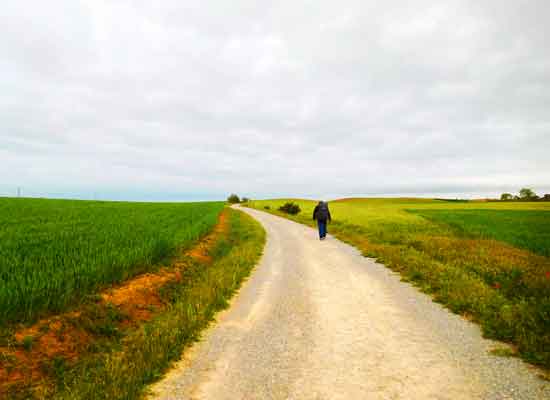
A few biscuits and a banana—that’s my breakfast before setting off this morning. Over the past few days, I’ve eaten plenty of bananas, but now, aiming for recovery through replenishing minerals, I plan to include them regularly. As is well known, bananas are rich in potassium, an essential mineral for muscle contraction.
At 6:30, I set off with my usual friends, but I quickly lose sight of them and end up walking alone, as my pace is slower than theirs. My physical condition seems to have improved, but reflecting on how things have gone in the past days, I’m not under any illusions that the issue is resolved.
Today’s stage is thirty kilometres long, so it’s quite a stretch, and the entire route is flat—the elevation of the terrain I’ll cross is virtually zero. We’re at an altitude of almost nine hundred metres above sea level, and the landscape remains unchanged, just like the past few days. The good news is that this time, there are several villages along the way, with relatively short distances between them. Another noteworthy fact is the weather: the temperature is cool, and the sky is covered with clouds suggesting rain. So once again, the “mesetas” will be merciful, sparing us unbearable heat.
Less than an hour after setting off, I arrive in Moratinos. Like many other pilgrims, I stop at the first bar I find in the village and enjoy a proper breakfast—a chocolate roll and a freshly squeezed orange juice.
Moratinos has fewer than eighty inhabitants and, like many other small towns along The Way, survives thanks to the pilgrims who pass through. A few years ago, the Albergue hospital San Bruno was opened here. It’s a private hostel housed in a typical Castilian home, featuring a large garden and patio, and it’s managed by Italians from the Brescia-based Association of Friends of The Way of Saint James.
Before resuming my walk, I put on my poncho and gaiters, as expected—it starts raining. I head down Calle Real, and as I walk along, I see the exterior of the Iglesia de Santo Tomás, a small 16th-century brick church that’s just as modest as the village itself. A wooden yellow arrow at the exit of Moratinos not only shows the direction to follow but also indicates that there are 376 kilometres left to Santiago de Compostela. A quick calculation tells me that I’ve already covered more than four hundred kilometres.
This time, the rain doesn’t last long and soon stops falling, although the sky remains heavy with clouds. As I move forward, the landscape ahead of me mirrors the one I leave behind, giving me the sense of standing still, as the scenery remains unchanged.
Around nine o’clock, I pass through San Nicolás del Real Camino, another tiny village with no one around—the last one in the province of Palencia. Here too, the small centre features a brick church dedicated to Saint Nicholas of Bari. Next to the church is the Albergueria Laganares, a small hostel with just twenty beds. Passing by, I see no sign of life; yet the hostel is open, and several tables and chairs outside give it a welcoming and homely appearance. I don’t stop because I don’t need to and because there’s still a long way to go before I reach the end of today’s stage.
Beyond the village, the dirt path runs parallel to the autovía Camino de Santiago.
– Yes, there’s even a motorway named after the ancient route leading to the city where the Apostle James is buried. –
– Hoping for a change in scenery? Well, here it is! –
Honestly, the monotony of a trail through fields would have been better than walking alongside a motorway, with lorries speeding by just metres away.
It’s about 9:20 when I cross the border into the province of León.
After walking for another half hour, I finally take a detour that leads me away from the motorway. Crossing a small stone bridge over the Río Valderaduey, I arrive at the Ermita de la Virgen del Puente, a 13th-century hermitage that once served as a hospital for pilgrims and lepers.
Here, I encounter three familiar faces—Tunner from Seattle, Eduardo from Mexico City, and Soobin from Seoul—practically a tiny cross-section of the world, where barriers, walls, borders, and racial discrimination don’t exist. Just the spontaneity and freshness of three young people who, starting from three different corners of the planet, have met on The Way and are naturally sharing this unique life experience. I enjoy remembering them at this moment of rest and capture their spontaneity in a photograph.
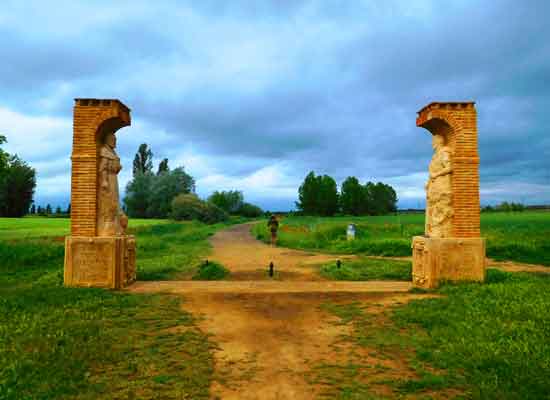
A few metres ahead, the path passes between two statues facing each other—one of Emperor Alfonso VI and the other of Abbot Bernardo de Seridad. Their position marks the geographical centre of the French Way. This is the midpoint of the route between Roncesvalles in Navarra and Santiago de Compostela in Galicia.
Reaching this point fills me with both pride, for the milestone achieved, and anxiety, knowing that I still have just as many kilometres to walk. If I also count the three stages after Santiago de Compostela leading to Finisterre, I’ll need to add another hundred kilometres to my journey.
Thinking about the physical problems I’ve been facing these past days, I worry about whether I’ll be able to complete The Way.
I continue walking for another two kilometres and arrive in Sahagún at around 10:30. This time, it’s a small town of about three thousand inhabitants, which was an important settlement in the late Middle Ages. There are several sights to see, so I don’t just pass through the centre. Instead, I take a moment to glance at the main landmarks of the town.
First, I see the Plaza de Toros, inaugurated at the beginning of the 20th century. After that, I pass by the Iglesia de la Trinidad, which currently serves as a tourist office, auditorium, and hostel. This hostel, called Albergue para peregrinos Cluny, can accommodate around sixty people. In the same area, I also take a look at the Iglesia de San Juan de Sahagún, built in a neoclassical style.
Besides the historical and artistic interest of the town, I also take the opportunity to look for a pharmacy. I buy magnesium and potassium tablets, hoping they will help me recover from the leg pain.
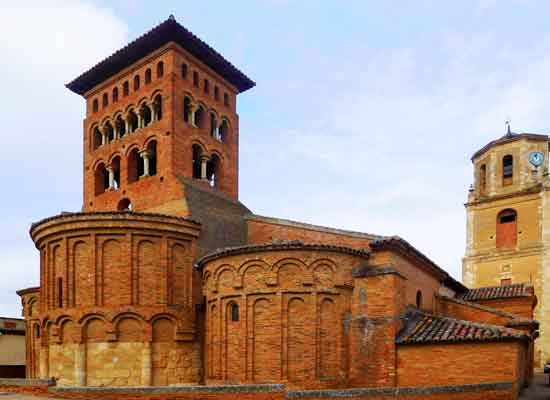
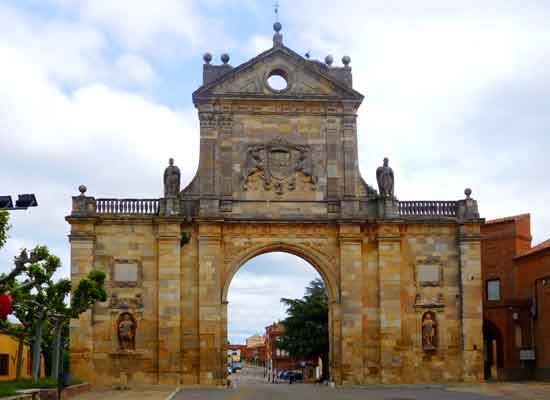
Continuing towards the centre, I visit the Iglesia de San Lorenzo and the Iglesia de San Tirso. These two medieval churches, not very close to each other, share the same architectural style—Mudejar Romanesque—and are built with bricks. Externally, they look very similar, almost like twins, especially the magnificent square bell towers divided into four levels, which give them a shared appearance.
In front of San Tirso, there’s the Torre del Reloj. Today, only one tower remains, but originally, there were two identical ones. Its twin was destroyed by a fire in the 19th century. The towers stood on either side of the entrance to the Monasterio Real de San Benito, an important Benedictine community in the Middle Ages. Over the centuries, wars, earthquakes, and a series of fires almost entirely destroyed this significant religious complex. Today, only three parts remain: the Chapel of San Mancio, the Torre del Reloj, and the Arco de San Benito. The latter, which was once a church portal, is now crossed by one of Sahagún’s main streets, resembling a triumphal arch.
After tending to my cultural interests and health needs, it’s time to satisfy my hunger.
– It’s just past eleven, and I think it’s the perfect time for a... tortilla! –
I stop at Albergue El Labriego, located in the western part of town, just before leaving the urban area.
Small and very welcoming, the hostel was recently converted from a 13th-century abbey. It also has a bar-restaurant, where I sit down to enjoy my tortilla. I can confidently say this is the best tortilla I’ve had during The Way.
I leave Sahagún, crossing the Puente Canto over the Río Cea. The bridge retains none of its Roman origins; the one we see today was built in the 18th century using stones from an unfinished chapel.
At 12:30, about four kilometres past Sahagún, The Way splits into two alternative routes of roughly equal length. A large stone stele clearly marks the division.
The path to the right, labelled “calzada romana,” is less recommended, especially on hot days due to the lack of shade and potable water. I take the route to the left, continuing along the French Way. My choice is determined by the fact that only this route leads to El Burgo Ranero, the destination I’ve set for today’s stage.
The end point is still quite far—over thirteen kilometres—and along the way, I’ll only come across one small village. For the rest, the landscape remains that of the “mesetas,” flat and dominated by farmland.
The weather also remains unchanged, and although it isn’t raining, the sky is grey, and the air is cold. So I keep my windbreaker on.
At around 14:00, I pass through Bercianos del Real Camino, a tiny village with about two hundred inhabitants.
The temptation to stop here is strong—I’m tired, and my legs hurt a lot. The pain in my shins has returned with more intensity. However, knowing that only seven kilometres remain and that I’ll find my friends at the end, I push myself to keep going. Stopping now would also mean adding many extra kilometres to tomorrow’s stage.
The pain is so intense that, at one point, I start screaming to release the tension. Since I’m alone in the middle of nowhere, there’s no risk of anyone thinking I’ve gone mad.
Shouting came naturally as a way to vent, but on second thought, it aligns with the “catharsis” stage in Osho’s dynamic meditation process. It’s the phase of “disinhibition,” where there are no rules, and everything is allowed to express one’s inner feelings and release them physically.
I scream again to let it out and gather strength. Now, however, I look forward to reaching the stage of “stillness,” the fourth phase described by Osho, where, in the absence of movement, one can feel all the energy within.
As I mentioned earlier, I’m walking alone, and I see very few pilgrims along the path. Those who occasionally pass me, due to my slow pace, soon disappear from view.
– Where has everyone gone? –
I can’t answer that question, but it seems obvious that, compared to the first weeks, the number of pilgrims along this stretch of The Way has significantly decreased. One reason might be that many took a bus from Burgos to León to skip the “mesetas.”
Even the friends I started with this morning have long disappeared from view, and I’ve had no further news of them. I imagine they’ve already arrived at the destination by now. Soon after, I get a call from Rocco confirming that he’s already at the hostel and has reserved a bed for me.
– Perfect! – I think. – As soon as I arrive, I can take a hot shower. –
An hour still separates me from the destination. Knowing that someone is waiting for me gives me the strength to endure the excruciating pain tormenting my legs, from the knees down.
– They say a phone call can save a life! –
Speaking of phones—before setting out on The Way of Saint James, I made a conscious decision to disconnect from daily life. Not because I wanted to escape something or someone, but because I wanted to fully immerse myself in the pilgrimage experience.
I did bring my smartphone with me, but not for calls or messages. I’ve only used it to call in emergencies.
To avoid constant interruptions, I usually keep it on airplane mode and even uninstalled WhatsApp to resist the temptation of checking messages. Occasionally, I update close family members just enough to let them know I’m still alive.
My smartphone, on the other hand, has proven extremely useful for all the other functions it offers, allowing me to leave quite a bit of weight at home—travel guides, notes, maps, my journal, and more.
For instance, the details in this account are thanks to all the voice notes I recorded on my phone along the way.
I imagine some might criticize my approach, arguing that it’s more “romantic” to write one’s travel memories in a journal or even in a Moleskine (in perfect Hemingway style).
I can agree with this critique, but it’s also true that my method is more practical, faster, and less cumbersome—and even more emotional.
By using this approach, I can also hear the background sounds from the places where I recorded my notes. Moreover, from the tone of my voice, I can sense the strain of a climb, the joy of reaching a goal, or even the suffering endured in those moments.
***
At 16:00, I finally arrive in El Burgo Ranero and check into the Albergue El Nogal. The last three hundred metres feel heavier than the thirty kilometres I’ve walked today.
– I’m absolutely exhausted and in pain! –
While I’m glad to have arrived and reunited with my friends, including those from Tuscany, I’m disappointed with the hostel. I rate it as the worst of all the accommodations I’ve stayed in during my journey along The Way.
Even the much-anticipated shower is far from satisfying—it’s cramped and not very warm.
The one good thing is that we have a large dormitory all to ourselves. However, I prefer to move to the adjoining room, where there’s a double bed just for me.
In the same room, besides my bed, there’s only one other, occupied by a German man. My roommate is an older gentleman with a rather large build. He seems quite tired but also quite relaxed, as if to say, “Wherever I stop, that’s where I rest.”
To add to the situation, the woman who runs the hostel is like a strict old-fashioned teacher. She treats us as though we’re schoolchildren in a Swiss boarding school, despite the place being quite run-down.
She keeps an eye on us and scolds us for every little thing we do.
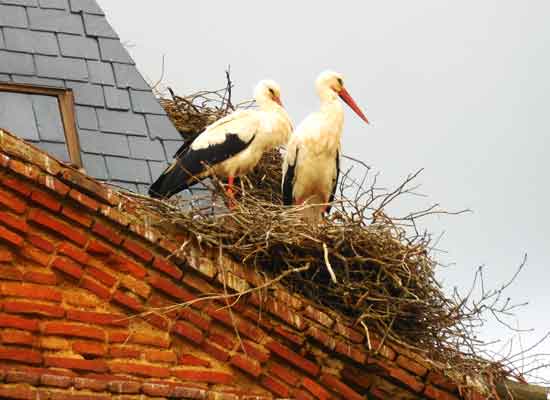
After my shower, I lie down on the bed. Despite the fatigue and leg pain, I only rest for about half an hour before heading out again for a stroll with Rocco.
The village, besides being small, is really unattractive.
If I had to say what excites me most about El Burgo Ranero, I’d have to mention the stork nests on the bell tower of the Iglesia de San Pedro Apóstol. Only by pointing my camera upwards and excluding the unsightly features at street level can I capture a few nice images to remember this stage.
The church is the most notable building in the village, but that doesn’t mean it has any significant artistic or historical value. On the contrary, it’s quite modest, and the only beautiful Romanesque sculpture it once housed has been moved to León Cathedral.
Back at the hostel, Dante informs us that tomorrow he plans to cover about forty kilometres to reach León in a single day instead of two. The idea was proposed by the Tuscans, and he suggests it to me and Rocco as well.
I immediately decline the invitation, primarily because of my poor physical condition and also because, as I’ve already mentioned, I don’t view The Way as a mere sporting activity focused on breaking records for distance and time.
Rocco seems tempted by the proposal but, noticing that I’m not going, decides to stick with me.
Around 19:00, we go out for dinner, choosing a restaurant not far from the hostel.
Once again, I stubbornly order paella, and once again, I’m disappointed to find it’s just a basic risotto. To make up for it, I treat myself to a sirloin steak with potatoes on the side, finishing off with dessert.
By the end of dinner, I’m completely worn out, especially since I didn’t rest enough in the afternoon.
At 21:00, I go to bed, bringing this long day to an end.
| © Aldo Lardizzone 2020 |  |
CREATIVE COMMONS |



